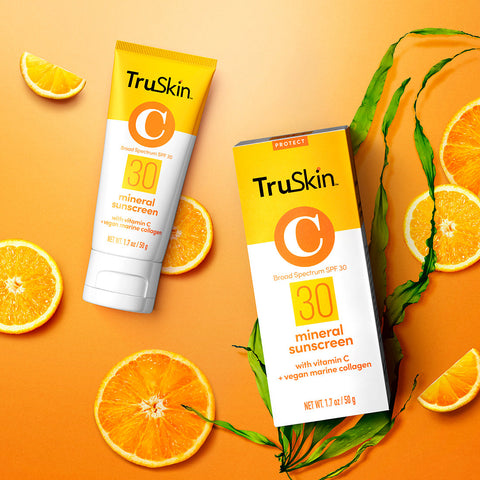
Without Doubt, The Best Things To Look Out For In A Sunscreen
It’s vital to make sure your sunscreen is doing everything it can to protect you from the sun’s evil rays. Here’s how to get on that.
The sun is annoying. When it’s out everything seems better. Your mood elevates, your spirit lifts, your hair looks shiny, heck even your complexion looks great. But beneath all that fabulous stuff lies some serious business. Because as awesome as the sun is – heck, we’d be non-existent without it – it’s just no good.
No good as far as your skin is concerned, anyway.
Ticking clocks aside, the sun is the number one cause of skin aging. In fact, it’s responsible for somewhere between 80 and 90 percent of all your aging skin concerns. Wrinkles? Sun. Loss of firmness? Sun. Dark spots? Sun. Almost always, you can point the finger at the sun. Also, did you know that over 80 percent of skin cancers are caused by overexposure to UV radiation?
As we said: the sun is no good.
Of course, we don’t recommend you close the blinds and never leave the house again. Drama, much? But being more sun savvy is something we can all accomplish. Staying out of the midday sun, wearing wide-brimmed hats and choosing protective clothing, for example – not too much to ask, right?
It's also wise to wear sunscreen whenever you expose your skin to the sun. It’s just common sense if you care about warding off premature skin aging for as long as possible. And it's an extremely important tool for preventing skin cancer which, according to the American Academy of Dermatology (AAD), around one in five Americans will develop at some point in their lives.
But what are the most important things a good sunscreen should offer or are they all decent enough? Well, in answer to the latter, no they’re not. And to answer the former, keep scrolling for the five most important things to look out for…
1. The Magic SPF Number
As we’re sure you know, a sunscreen’s SPF value is there to show you how well it’s going to protect you from burning. Low numbers offer you less protection whereas high numbers give you much greater protection. Simple enough, right? Ha, if only. Going by these rules makes it tempting to choose insanely high SPF ratings in a bid to protect your skin as best you can. However, the truth is that SPF 30 actually blocks a whopping 97 percent of UVB radiation, so anything higher than that is going to be very minimal. SPF 50, for example, only blocks an extra 1 percent, and studies show that anything above that provides almost no additional protection whatsoever.
That’s why we believe, along with most skin experts, that SPF 30 is the sweet spot.
Also, what about UVA radiation? Well, we’ll come to that in a minute because SPF doesn’t go there, it’s only an indication of UVB protection – the one that causes sunburn – not UVA which is present all year long and the biggest offender of skin aging. An easy way to remember which is which? Think UVA for aging and UVB for burning.
2. The Term ‘Broad Spectrum’
So you’ve got your UVB protection sorted thanks to SPF, but how do you know your product will also protect you from UVA radiation? After all, UVA rays are around every day, eating away at your collagen supplies and aging up your skin like nobody’s business – even on cloudy days. They’re arguably the worst of the lot.
Thankfully, there’s a simple way to ensure you’re getting the right level of UVA protection from your sunscreen: only ever buy broad spectrum. Any product that doesn’t mention this term? Not worth your dollars.
A broad-spectrum formulation that has SPF 30 is ideal for providing you with the optimum level of protection from both UVA and UVB radiation. It’s what we like to call the best of both worlds.
3. The Gold Standard Mineral Protection
There are two types of sun protection – mineral and chemical. Chemical sunscreens use ingredients like oxybenzone, octisalate, avobenzone, octocrylene and octinoxate to absorb and break down UV rays where they are then released back out through your skin. They’re pretty smart, but some experts believe they cause hormonal disruption as well as damage to the planet’s waterways and marine life. We’re not keen on any of that.
Mineral (or physical) sunscreens, on the other hand, contain active mineral ingredients like zinc oxide and titanium dioxide. These sit on the surface of your skin, forming a physical, reflective barrier against UV radiation, and we believe they’re way more effective at stopping the sun’s rays from potentially damaging your skin.
Both zinc oxide and titanium dioxide naturally protect your skin from UVA and UVB radiation which is another plus point and why they’re the only two sunscreen ingredients currently proposed safe and effective by the FDA. They’re also environment friendly and provide instant protection for your skin. Chemical sunscreens have to be applied at least 20 minutes before exposure.
Mineral protection is the only way to go, IOHO.
4. The Antioxidant Extras
Products that go the extra mile for your skin are priceless. So, if you really want to maximize the effects of your sunscreen, look out for formulations that also contain antioxidants.
Antioxidants fight tooth and nail to shield your skin from the damaging effects of free radicals, and exposure to the sun is one of the biggest causes of free radicals. When you put two and two together, therefore, it makes perfect sense that antioxidants should be a non-negotiable part of your daily skincare routine.
Studies have shown that one of the best antioxidants for sun protection is vitamin C. It’s genius for neutralizing any free radicals that are trying to do a number on your collagen supplies, plus it makes your sunscreen work harder and better by improving the absorption of UV radiation.
If that’s not enough to convince you, vitamin C also helps reduce and fade dark spots by blocking melanin production. The good news is that our SPF 30 Mineral Sunscreen contains a hefty amount of antioxidant-rich vitamin C so it does all the hard work for you. You're welcome!
5. The Best Possible Water Resistance
OK, so this one isn’t quite as important for your daily facial sunscreen – unless you spend all day, every day in a swimming pool or the ocean – but when on vacation, a water resistant formulation is vital.
In order to have the term ‘water resistant’ on its label, a product has to be tested to offer resistance from the clear stuff for at least 40 minutes. After that period of time, you MUST reapply.
However, let’s get one thing clear, sunscreens can never be entirely waterproof (it’s impossible), so if you see that written on a bottle that’s a red flag right there. It’s also disallowed by the FDA so... naughty.












